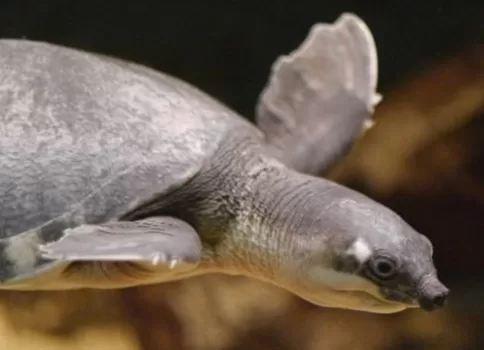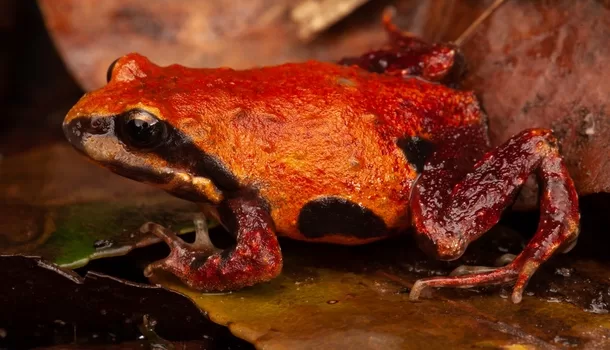Australia’s threatened species list has expanded once again, with eight animals and five plants added in the past month alone. The new additions highlight the ongoing environmental crisis facing the nation’s unique flora and fauna, which are increasingly at risk due to habitat destruction, climate change, and human activities.
The latest fauna listings include three freshwater fish, three lizards, a frog, and a turtle, all of which are now classified as endangered or critically endangered. The flora updates feature one rainforest tree, two flowering shrubs, a daisy, and an orchid species, each facing significant threats from deforestation and habitat degradation.
“Australia has the most reptile species on the planet, and more than 90% of them are not found anywhere else, so it’s really sad to see three more lizards added to the list,” said Darcie Carruthers, a nature campaigner with the Australian Conservation Foundation (ACF). “The Hunter Valley delma, a legless lizard, was only named a species in 2022, and two years later, it is declared endangered.”
Advertisement:
The Hunter Valley delma’s plight is particularly alarming. More than 90% of its known habitat in New South Wales’ Hunter Valley has been damaged by open-cut mining and agricultural activities. The species now finds itself trapped in a shrinking habitat that is home to at least 20 coal mines.
Plant species are also suffering under the pressure of deforestation. The Coffs Harbour Fontainea, a rainforest tree, has been rapidly pushed to the critically endangered category. This species is now only found in two pockets of bushland, both of which are owned by Transport for NSW and are located within the boundaries of a road project. Despite its endangered status, one of these sites is slated to be cleared for the construction of the Coffs Harbour bypass.
Equally concerning is the fate of three freshwater fish species from South Australia’s Witjira-Dalhousie Mound Springs. These springs, fed by the Great Artesian Basin, are drying up due to water extraction for mining, petroleum operations, and pastoral use, pushing these fish species closer to extinction.
“As is the case for so many plants and animals, climate change is exacerbating other threats,” Carruthers added. “These latest listings show our nature laws are powerless to stop Australian plants and animals from being willfully destroyed. Australia’s forests, lizards, bush, wetlands, and frogs need nature laws with teeth and a truly independent Environmental Protection Authority to enforce them.”
New species added to Threatened List
The growing list of threatened species now stands at 2,224, reflecting an alarming trend. The ACF’s analysis revealed that more species were added to the national threatened species list in 2023 than in any other year since the list was established, underscoring the urgent need for stronger environmental protections and proactive conservation measures.
Dalhousie Goby (Chlamydogobius gloveri) – Critically Endangered
The Dalhousie goby is a small freshwater fish endemic to the Dalhousie Springs in South Australia. This goby has adapted to the unique thermal conditions of the artesian springs, but its extremely limited habitat makes it highly vulnerable to environmental changes. Habitat degradation, primarily due to water extraction and the invasion of non-native species, has pushed this species to the brink of extinction.
Dalhousie Hardyhead (Craterocephalus dalhousiensis) – Critically Endangered
Found only in the Dalhousie Springs in South Australia, the Dalhousie hardyhead is a small fish that thrives in the warm, mineral-rich waters of these isolated springs. The species faces severe threats from habitat disturbance and the introduction of invasive species, which have drastically reduced its already limited range, leading to its critically endangered status
Dalhousie Catfish (Neosilurus gloveri) – Critically Endangered
The Dalhousie catfish is another endemic species restricted to the Dalhousie Springs in South Australia. This species is highly specialized to its unique thermal spring environment, making it particularly vulnerable to habitat changes. The extraction of groundwater and the introduction of non-native species have significantly impacted its population, leaving it critically endangered.
Pig-nosed Turtle (Carettochelys insculpta) – Vulnerable
The pig-nosed turtle is a unique freshwater species found in the rivers of northern Australia and southern New Guinea. Known for its distinctive pig-like snout, this turtle is vulnerable due to habitat destruction, illegal poaching for the pet trade, and climate change, which affects its breeding sites. Conservation efforts are ongoing to protect this species from further decline.
Pugh’s Sphagnum Frog (Philoria pughi) – Endangered
Pugh’s sphagnum frog is a small, ground-dwelling frog found in the high-altitude rainforests of northeastern New South Wales, Australia. This species relies on the moist sphagnum bogs and streams for breeding, but habitat loss due to land clearing and climate change threatens its survival. With its restricted range, this frog is listed as endangered and is the focus of conservation efforts.
Hunter Valley Delma (Delma impar) – Endangered
The Hunter Valley delma is a small, legless lizard found in the grassy woodlands of the Hunter Valley in New South Wales, Australia. Its habitat is under pressure from urban development, agriculture, and habitat fragmentation. This has led to a significant decline in its population, placing it on the endangered species list.
Alpine Water Skink (Eulamprus kosciuskoi) – Vulnerable
The alpine water skink is a reptile native to the high-altitude regions of southeastern Australia, particularly in the Australian Alps. This species thrives in cold, wet environments, often near streams and bogs. Climate change, habitat loss, and increased human activity in alpine areas have led to a vulnerable status for this skink, with concerns for its long-term survival.
Ringed Thin-tail Gecko (Strophurus taenicauda) – Endangered
The ringed thin-tail gecko is a distinctive gecko species found in dry forest and woodland areas of eastern Australia. This gecko is known for its bright coloration and thin tail. However, habitat destruction, primarily due to land clearing and fragmentation, has caused significant population declines, leading to its endangered status.
Spyridium cinereum – Endangered
Spyridium cinereum is a rare shrub species native to Victoria and South Australia. This plant thrives in sandy soils, often in coastal heathland environments. Due to its restricted range and the ongoing loss of habitat from coastal development and invasive species, Spyridium cinereum is considered endangered and is subject to conservation measures to protect its remaining populations.
Brachyscome brownii – Critically Endangered
Brachyscome brownii is a critically endangered small herbaceous plant native to Tasmania. Found only in specific high-altitude regions, this plant is threatened by habitat loss due to land clearing, invasive species, and climate change. Its critically endangered status highlights the urgent need for habitat protection and restoration efforts.
Fontainea sp. Coffs Harbour – Critically Endangered
Fontainea sp. Coffs Harbour is a critically endangered plant species found in a very limited area near Coffs Harbour in New South Wales, Australia. This species is under severe threat from habitat destruction due to urban development and agricultural expansion. Conservation efforts are focused on protecting its remaining habitat and preventing further decline.
Sannantha whitei – Critically Endangered
Sannantha whitei is a critically endangered shrub native to the coastal regions of southeastern Queensland and northeastern New South Wales. This species is at high risk due to habitat fragmentation, invasive species, and land development. Its critically endangered status underscores the need for habitat conservation and restoration to ensure its survival.
Caladenia amnicola – Endangered
Caladenia amnicola is an endangered orchid species found in Western Australia. This delicate and rare plant is highly susceptible to habitat loss, particularly from land clearing, agriculture, and climate change. Conservation efforts are crucial to protect this species from further decline, as its survival depends on preserving its natural habitat.
As Australia grapples with this escalating crisis, conservationists and environmental advocates are calling for robust reforms to safeguard the country’s unique biodiversity before it’s too late.
Related stories
NSW Rural Fire Service Aircraft Fleet
RFS Firefighters Unite North America and Australasia
Integrating Indigenous Knowledge into Bushfire Management
Mistake State Forest: A Battle for Preservation
Targeted Logging Threatens Great Koala National Park
Replacing timber power poles saves our forests
People’s Court Finds Tasmania Politicians and Loggers Guilty
Murray Darling Basin Water Markets Lose $2 Billion
Advertisement:




